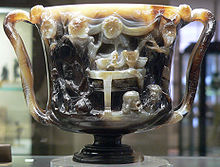- Cup of the Ptolemies
-
The Cup of the Ptolemies (Coupe des Ptolémées) is an onyx or chalcedony cameo two-handled cup (kantharos), now conserved in the Cabinet des Médailles at the Bibliothèque National, Paris.[1] Until September 1791 it formed part of the treasury of the Basilica of Saint-Denis. It was stolen in 1804, and recovered without its Carolingian gem-studded gold mountings.[2] It is 8.4 cm high with a diameter of 12.5 cm.
The two-handled cup, one of the acknowledged masterpieces among hardstone carvings or engraved gems of Antiquity,[3] was carved with Dionysiac vignettes and emblems, probably in Alexandria during the 1st century BC or the first century after. It gained its reputed connection with the Ptolemies in the description by Jean Tristan de Saint-Amant (1644),[4] who believed that this vase was made to the command of Ptolemy II Philadelphus (died 246BC). In the early Middle Ages the cup was recommissioned to serve as a chalice; during the Carolingian era it was fitted with gem-studded gold mounts, now removed and known only through an engraving by Michel Félibien.[5] The mounts bore the two-line legend hoc vas Christe tibi mente dicavit/ Tertius in Francos regmine Karlus, which linked the mounting directly to Charles the Bald (died 877), perhaps in workshops of Saint-Denis itself.[6]
The Coupe des Ptolémées figured in the coronation of the French monarch, at which, according to S.G. Millet,[7] the queens "take ablution from this chalice, after holy communion".[8]
It is mentioned in H.P. Lovecraft's treatise Supernatural Horror in Literature.
Notes
- ^ Babelon 368; D. Gaborit-Chopin, Le trésor de Saint-Denis, exhibition catalogue, D. Alcouffe, D. Garborit-Chopin et al., Paris: Musées du Louvre, 1991, no. 11, pp 38-40.
- ^ Treasures of Saint-Denis: Chalice of the Ptolemies
- ^ "the most precious vase that is in the treasure of Saint-Denis, and perhaps in any European cabinet." (Michel Félibien, Histoire de... Saint-Denys, Paris, 1706, pl. vi, at full scale); "one of the greatest treasures in the Cabinet des Médailles" (Sir W. Martin Conway, 1915, pp 119f (on-line); etc.
- ^ Saint-Amant, Commentaires historiques, contenants l'Histoire des Empereurs, Impératrices, Caesars et Tyrans de l'Empire Romain(Paris, 1644), noted by Conway 1915.
- ^ Félibien, Historie de,,, Saint-Denys (Paris, 1706) pl. vi illustrates the cup with its Carolingian mounts.
- ^ Illustrated (fig. 11. and briefly discussed in Leslie Webster, "Ædificia nova: treasures of Alfred's reign", Alfred the Great, Timothy Reuter, ed. 2003, pp. 97ff.
- ^ Millet, Le Trésor... de Sainct-Denys (4th ed. Paris, 1645), noted by Conway 1915.
- ^ prennent l'ablution en ce calice, aprés la saincte communion (Millet 1645, p. 110).
Categories:- Roman Empire cameos
- Ptolemaic Kingdom
- Hellenistic art
- Hardstone carving
Wikimedia Foundation. 2010.


